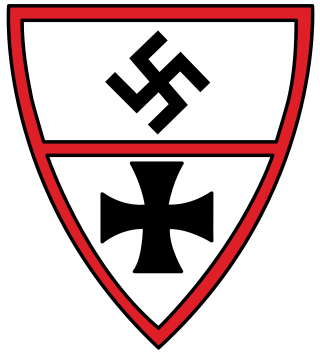History
The Corps was first known as Höheres Kommando z.b.V. XXXIV (H.Kdo.) and was established on 15 October 1939 in Küstrin. After the Invasion of Poland, the H.Kdo was stationed there between December 1939 and June 1941.
After the start of Operation Barbarossa (June 1941), the H.Kdo saw its first action at the beginning of July 1941 in the Battle of Kiev (1941). As part of the 6th Army, the H.Kdo formed part of the southern flank along the Dnieper River. After successfully completing this battle, the H.Kdo advanced with the 2nd Panzer Army towards Moscow.
The H.Kdo. marched via Livny towards Yelets, where the advance was halted. The Soviets launched their Yelets counter offensive on 6 December 1941. The XXXIV H.Kdo., composed of the 45th and 134th Infantry Divisions, was surrounded and partly destroyed. The survivors retreated towards Oryol and Kursk. The front line stabilised on December 17, 1941, but had moved almost 100 km back to the west. The H.Kdo. had lost 12,000 men and was hardly a combat-ready unit any more.
On 31 January 1942, the H.Kdo. was disbanded and its survivors added to the newly formed XXXV Army Corps.
On 13 November 1944, the XXXIV Corps was recreated from Kommandanten Kreta a.k.a. Korps Müller, which had retreated from Crete. The Corps was stationed around Vukovar and held the Syrmian Front between Danube and Sava until mid-April 1945. On 12 April 1945, the Yugoslav First Partisan Army, broke through the XXXIV Corps' defenses in Syrmia, and captured the cities of Vukovar, Vinkovci, Županja, and finally Zagreb in the last month of the war.
The Corps retreated towards the west and surrendered to the British in May 1945.

III Army Corps was a corps level formation of the German Army during World War II.
XVIII. Armeekorps was formed in Salzburg, Austria, on 1 April 1938, following the Anschluss of Austria into the German Reich. During the life of the XVIII. Armeekorps, they took part in the Polish campaign, Fall Weiss, and the campaign in the West 1940, and performed occupation duties in France. On 30 October 1940, the Corps gave up some elements to newly forming XXXXIX. Gebirgskorps, and on 1 November, they re-designated the Korps name to XVIII. Gebirgskorps.

German XI. Corps was a corps in the German Army during World War II.

VIII Army Corps was a corps in the German Army during World War II. It was destroyed during the Battle of Stalingrad and reformed in mid-1943.
IX Army Corps was a corps in the German Army during World War II. It was formed on 1 October 1934 under the command of General Friedrich Dollman in Kassel with the camouflage name of Kassel and redesignated IX Corps after the creation of the Wehrkreis IX recruitment and training area.
German XXIII. Corps was a corps in the German Army during World War II.
X Army Corps was a corps in the German Army during World War II. It was formed in mid-May 1935 from the Cavalry Division.

XXXXII Army Corps was a corps in the German Army during World War II.
German XXX. Corps was a corps in the German Army during World War II.
German XXXV. Corps was a corps in the German Army during World War II.
LV Army Corps was a corps in the German Army during World War II.

XXXXIII Army Corps was a corps in the German Army during World War II.
German XXXIII. Corps was a corps in the German Army during World War II.
The Höheres Kommando z.b.V. XXXI was a special Corps in the German Army during World War II.
The LXX Army Corps, initially known as Higher Command z. b. V. LXX or Höh.Kdo.70, was an army corps of the German Wehrmacht during World War II. Throughout the war, it was deployed in occupied Norway.
The LIX Army Corps, initially known as the Higher Command for Special Deployment LIX was an army corps of the German Wehrmacht during World War II. The formation was active between 1940 and 1945.
The LXXI Army Corps, initially known as Higher Command LXXI or Höh.Kdo. röm. 71, was an army corps of the German Wehrmacht during World War II. The corps was deployed in March 1942. Throughout the war, it was stationed in the north of occupied Norway.
The LXXXII Army Corps was an army corps of the German Wehrmacht during World War II. It was formed in 1942 and existed until 1945.
The LXXXIII Army Corps was an army corps of the German Wehrmacht during World War II. It was formed in 1942 and existed until 1943. After its dissolution, the personnel of the LXXXIII Army Corps was used to form the staff of the new 19th Army.
Alfred Wäger was a General of the Infantry in the Wehrmacht of Nazi Germany during the Second World War who commanded several units. He was a recipient of the Knight's Cross of the Iron Cross.
This page is based on this
Wikipedia article Text is available under the
CC BY-SA 4.0 license; additional terms may apply.
Images, videos and audio are available under their respective licenses.




